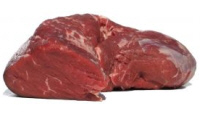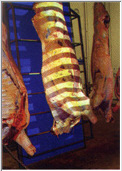



Technological Milestones from Carcase to Product
The role of science and technology is playing an increasingly important part throughout the meat and livestock industry. This trend is particularly evident in the processing sector, where meat quality, taste, carcase grades and value can now be determined almost completely automatically, writes Adam Anson, reporting for TheCattleSite Adam Anson. |
| A prime piece of meat? Photo: Stockxchng |
What happens after a producer has taken his animals to slaughter plays a crucial part in the quality of the final product. Whilst important factors such as meat tenderness can be influenced by the breed, age, husbandry and fatness of the animal, small issues such as the stress levels and temperature of the animal in the hours before slaughter can have an overwhelming effect on the final tenderness of the meat.
Dr Ian Richardson, Head of Food Science and Food Safety Group, told an audience at the 2009 Quality Meat Scotland Research and Development Conference that once the animal has been slaughtered it is up to the processor to cool the carcase quickly, before rigour mortis sets in. However, in beef this takes place between 10 and 30 hours after slaughter. If the carcase is cooled too quickly then the muscle will shrink. This is called cold shortening. "As the meat shrinks the cells become to packed for enzymes to move properly between them," explained Dr Richardson, resulting in a tough meat product with less volume.
On the other hand, the opposite affect - heat shortening - can also have a detrimental affect on the size of the meat. This occurs when the carcase has not been sufficiently chilled before it goes into rigor. However, according to Dr Richardson, the shortening does not generate the same tension as cold shortening so the effect is not so severe.
Scientific analysis has shown processors that they can avoid cold shortening by cooling the carcases at a certain rate. Dr Richard's trial data showed that temperature should not be below 10 degrees celsius for the first 10 hours of chilling. However, failing this electrical stimulation can protect against cold shortening and may also improve meat tenderness, colour, and appearance, he said.
Electrical stimulation causes the carcass muscle to contract violently and hastens the conversion of muscle to meat. The pH level drops more quickly than usual allowing for early rigor mortis. It also hastens the development of quality characteristics such as bright red muscle colour, muscle firmness, and marbling. Aging time of electrically stimulated beef is also reduced, but too much electrical stimulation can actually force the carcase into a heat shortening state.
As the carcase ages other factors can affect the quality of the final meat product. One question that is often asked is which method - dry or wet ageing - provides better value, said Dr Richardson. Ageing meat both on or off the bone are both acceptable for tenderness he said, but ageing on the bone leads to a high shrink which can be costly. It is argued by many that the result of this process creates a superior product. Alternatively, whilst vacuum packed meat products retain their volume, Dr Richardson added that they tend to pick up "sour flavours".
Generally dry aged meat scores higher on texture, juiciness and flavour, but factors also include the length of time the meat is left for. Whilst carcase storage requires further expenses, the texture is noticeably better in a 28 day carcass than a 10 day carcase. However, during this time, flavour actually declines.
Predicting Carcase Grades
Meat quality and the value of the carcase is determined just after the animal has been slaughtered and eviscerated. Using a good eye, classifiers (human graders) can determine the size of the carcase, the muscle depth in the prime cut areas around the ribs and the hind, and also the fat layering. A subsequent grading system calculates the value of the overall carcase, by estimating the overall yield.

However, classifiers are now being replaced with automated grading systems that can invariably give a greater evaluation of the carcase. One such system is now in practised in Ireland. Elisenda Rius Vilarrasa, from the Scottish Agricultural college, introduced the QMS audience to the Video Image Analysis (VIA) system VBS2000. Originally developed in Germany by E+V, the system uses a holding frame for the carcass and a single colour camera. Striped light is shone across the carcase, highlighting the curves and dips which can then be used to process a three dimensional shape. The information is then sent to a computer system which analyses the striped image and compares it against 615 carcases that were taken in the authorisation test as a base for classifiers. Using this information, the system can predict EUROP and saleable yield.
Analysis of the systems success to date has reported that the VIA systems offer a higher consistency than classifiers, but they are better for conformation than they are for fatness prediction, said Mr Vilarrasa. Following the Irish trials 25, VBS2000 systems were installed and about half of which had saleable yield software. Understandably there has been some initial scepticism of VIA systems from producers, as the payments they receive are linked to grades.
The VIA system has opened the door for new automated grading system initiatives. One current experiment asks if grading can be done more accurately by X-ray Computer Tomography (CT) scanning, whilst also retaining an efficient line. CT image analysis is based on differences in attenuation of X-rays on tissues and objects due to differences on their real densities. Tissues will appear on CT images with different grey shades, which indicate these densities. It is possible from this process to determine the volume of a carcass and also the exact depth of fat, muscle and even bone.
The French pig institute, IFIP, has invested €600,000 in a mobile tomography unit that can carry out 3D X-ray analysis of anything from primal joints up to a half carcase. The medical X-ray scanner has an imaging diameter of 50 centimetres – so small that anaethetised animals can also be scanned. The scanning unit can resolve thicknesses to within one millimetre, generating 16-bit images. So far, volumetric results from the unit have been accurate to within one per cent of dissection results.
Another type of grading system that has recently been developed is the near infrared reflectance (NIR) spectroscopy, determining sensory characteristics of meat. The hand held device is used to analyse the tenderness of a meat cut through the NIR wavelengths measurements.
Despite of this growing trends toward automated meat quality assessment, Meat Standards Australia has begun a more human approach. Rather than relying on automated technology to decide the value of a carcase to the final consumer, a table of taste standards and a board of taste-testers has tried to hone down what we regard as quality meat. Meat from different cuts, species and sizes of livestock have been compared against one another, which have helped to set a new standard of carcase value on a basis of a consumer desire. The knowledge that has been gathered through these tests has also been passed down to Australian producers to help them produce the right kind of animal.
In the test Ratings on tenderness are multiplied by 0.4, juiciness is multiplied by 0.1, flavour is multiplied by 0.2 and overall liking is multiplied by 0.3. The results of these ratings are then multiplied together to give a five star rating of meat quality. The overall figures then fall into the categories: unsatisfactory; good/everyday; better than everyday; and gourmet.
The MSA Grading model takes each cut and gives it a rating out of five indicative of its quality when used in different cooking methods. Methods include grilled steak, roast beef, stir fry, thin slice, casserole and corned beef. Tenderloin cuts scored the highest rating when gilled roasted and stir fried. The only other top rating score in the entire model came from a thin sliced oyster blade cut.
Predicting carcase grades can have a profound affect on the meat industry and the variation of products which appear on supermarket shelves. These new techniques have the potential to bring better predictions of carcase yield for meat, fat and bone. They offer processors the ability to select premium products and possibly even guarantee tenderness. Enhanced grading will empower the processor to give more knowledgeable feedback to the producer and data can also be passed down for research projects enhancing meat quality yet further still. Production systems, genetics, diets and growth rates can all, to some degree, be enhanced from a meat quality/cost objective.
The new grading systems also offer the chance to move carcases into more specific grades, weeding out inferior meats whilst highlighting the real premium products. A huge amount of data can be collated with these new systems which can then be analysed to discover which animals really are the best breeds and which cuts are the tastiest, but in spite of all these technological advancements, the only true test of meat quality, is the individual who eats it.


